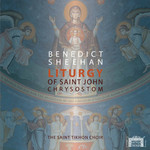|
Back
10/20/2020
Benedict Sheehan: Liturgy of Saint John Chrysostom
Timothy Parsons (countertenor), Michael Hawes (baritone), Dr. Jason Thoms (bass), the Saint Tikhon Choir, Benedict Sheehan (conductor)
Recording: St. Stephen’s Pro-Cathedral, Wilkes-Barre, Pennsylvania (May 28-29, 2019) – 75’33
1 CD and 1 Pure Audio Blu-ray Cappella Records CR421 – CDBR (Distributed by Naxos of America) – Booklet in English

   
Liturgical music holds a unique place for believers, and its importance varies from faith to faith. Some religions in their strictest form have no music (Society of Friends) while others find in sacred music the highest form of worship.
In the liner notes to the new album, Liturgy of Saint John Chrysostom, the composer of this work, Benedict Sheehan, describes music in the Orthodox Christian tradition as “In a sense, a recapitulation of existence itself in order to bring it into contact with eternity.” In the Orthodox faith, nothing can bring people closer to an invisible God than the unseen, transformative presence of music.
Just such music is Sheehan’s setting of the Orthodox liturgy, the scaffold on which religious communities in the Eastern tradition drape their service of worship and atonement, gratitude and praise. Although “great composers” like Tchaikovsky and Rachmaninoff have provided settings for the liturgy of the Russian church, it is not a form that commonly finds its way to the concert stage.
Music lovers in the Western European mode may go to a classical concert and listen to a Haydn mass or Mozart’s Requiem, which follow a Roman Catholic model, but it would be much less common to hear Rimsky-Korsakov’s setting of the Eastern service. The Roman Catholic Mass may be scored for symphony orchestra, or at least an organ, and chorus. The Russian service, in contrast, is composed solely for voice. The composer is challenged to gain the most expressive power by focusing on harmonic relationships and the use of choral lines that lead to the experience of the transcendent.
This is a long introduction to a recording which succeeds fully as a musical work, albeit one that follows strict compositional and theological guidelines. Despite the heaviness of its intention, I found this work surprisingly elegant and light, perhaps leavened by the delightful high voices of the choir, always smooth, never shrill, and by countertenor Timothy Parsons. Of course, where would an Orthodox performance be without the haunting resonance of bass voices? They were in evidence throughout, providing a musical substratum in several sections over which Sheehan layered, like sheer ribbons, sometimes achingly beautiful striations from the higher voices.
An hour and a quarter in length, the Liturgy deserves to be listened to in a quiet room with no distractions. Listeners would do well not to attempt to listen while driving, on the phone, or grabbing a late lunch. It is a work which commands not only attention, but respect, even if one has nothing in common with the religious teachings it imparts through song.
The Liturgy is in English, sung by the Saint Tikhon Choir, a professional ensemble conducted and co-founded by the composer. The choir’s other co-founder is Abbot Sergius of the Saint Tikhon Monastery, a two-hour drive north of Philadelphia in the United States.
The CD of the album includes two disks. The first contains the entire Liturgy in 17 sections, beginning with the “Great Litany” and concluding with “Blessed be the Name of the Lord”. The second disk offers the Liturgy as a Pure Audio Blu-ray which will play in any standard Blu-ray player.
Though consonant with our ideas of how a sung Liturgy should sound, Sheehan’s composition is definitely modern in feeling and ideas. However, I would say modern in the manner of Pärt and Rutter rather than in the style of, say, Penderecki and Aho. There are no extreme rhythms, though the score moves along with a lively sense of animation. Any discords are of the sort that glide neatly across each other, like ships passing in the night, or as flower buds struggle before they bloom. The work’s great impression of strength reminds me of the spider’s web, catching a four-course dinner in a hint of lace. The Liturgy score offers much that is appealing and familiar in the way of purely musical activity. A motif announced in the opening “Litany” may be found in each of the 17 sections.
Sheehan has an infallible ear for determining a balance between high and low voices, especially effective in the “Third Antiphon” (“The Beatitudes”) where each of the blessings is sung responsively (e.g., “Blessed are the meek...” sung by lower voices, then “for they shall inherit the earth...” replied in higher voices). Even here there is a variety in the melodic writing for each Beatitude which holds our interest and makes the ancient message fresh and meaningful.
While many musical choices are dictated by liturgical necessity, overall, this album is an addition of rare grace and refinement to the living music heritage of the Eastern rites. It will delight the Orthodox and the discerning non-Orthodox music-lover equally, and, perhaps, in its own way, contribute to greater understanding in a fragmented and disjointed world.
Linda Holt
|